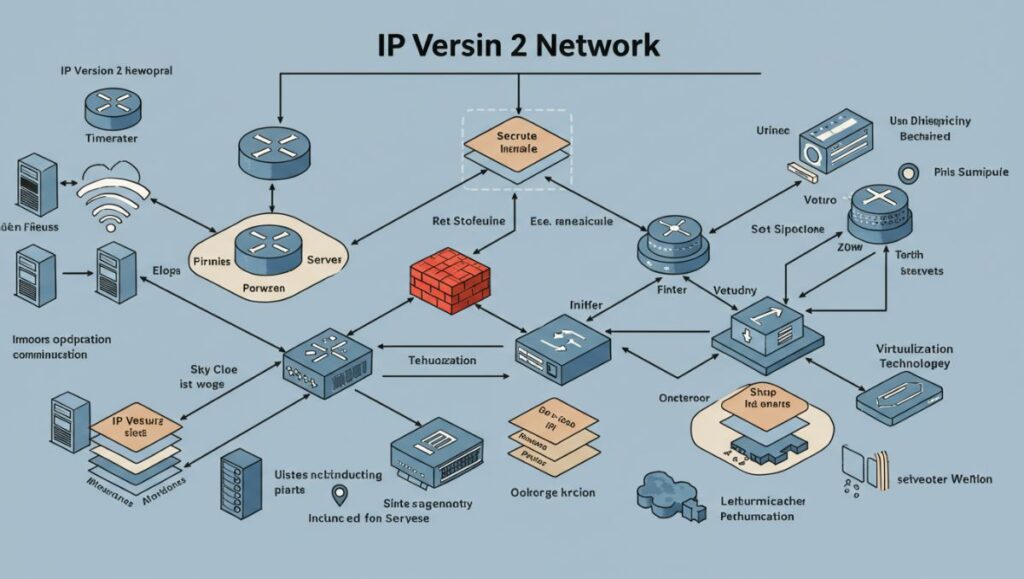As the world moves deeper into the digital era, networks have evolved far beyond simple connectivity. Today, they form the foundation of cloud computing, IoT, AI-driven automation, and global communication. Among the new frameworks driving this evolution is the IP2 Network, a modern networking model built around the next generation of Internet Protocol intelligence and infrastructure efficiency.
The IP2 Network represents a strategic evolution of IP-based communication, emphasizing speed, scalability, security, and smart routing. It’s not merely a protocol—it’s an integrated ecosystem for optimizing data flow, managing resources intelligently, and ensuring reliable communication across distributed environments.
What Is the IP2 Network?
The IP2 Network, short for Internet Protocol Version 2 Network (in some contexts, “Intelligent Protocol 2 Network”), refers to an advanced network architecture designed to enhance data transmission, security, and interoperability over standard internet infrastructures.
It builds upon traditional TCP/IP frameworks but incorporates automation, analytics, and adaptive routing capabilities, enabling smarter communication between digital systems and devices.
Core Concept
The IP2 Network merges three technological domains:
-
Internet Protocol (IP) – the core addressing system for global connectivity.
-
Software-Defined Networking (SDN) – centralized network control through software logic.
-
AI-Driven Optimization – predictive traffic management and security intelligence.
Together, these create a dynamic environment where data routes, bandwidth, and security policies adjust automatically in real time.
The Evolution from IP to IP2
To appreciate the IP2 Network, it’s important to understand how Internet Protocol itself has evolved:
| Generation | Protocol | Key Features |
|---|---|---|
| IP Version 4 (IPv4) | 1980s | 32-bit addressing, limited scalability |
| IP Version 6 (IPv6) | 1998 | 128-bit addressing, improved routing and security |
| IP2 Network (Next-Gen) | 2020s | Intelligent automation, AI-based routing, integrated cybersecurity |
While IPv6 solved the problem of address exhaustion, it didn’t inherently improve network intelligence. IP2 bridges that gap, introducing self-managing, self-healing, and self-optimizing capabilities into IP communication.
Architecture of the IP2 Network
The IP2 Network follows a multi-layered intelligent architecture that integrates traditional IP layers with advanced control and analytics systems.
1. Data Layer
Handles the physical transmission of packets over wired, wireless, or optical links. It maintains compatibility with existing Ethernet, fiber, and 5G technologies.
2. Control Layer
Acts as the “brain” of the network. This layer uses SDN controllers to monitor traffic patterns, optimize routing, and enforce policies dynamically.
3. Application Layer
Interfaces with user-facing systems and enterprise applications. APIs allow integration with cloud services, IoT platforms, and AI-driven analytics tools.
4. Intelligence Layer
Unique to IP2, this layer uses machine learning algorithms to analyze real-time traffic data, detect anomalies, predict congestion, and reroute data to ensure efficiency and security.
Key Features of IP2 Network
1. Intelligent Routing
Instead of relying solely on static routing tables, IP2 Network uses AI-based route optimization that learns from traffic patterns, latency measurements, and congestion reports.
2. Self-Healing Capabilities
When a network failure or bottleneck occurs, IP2 automatically reconfigures routing paths without human intervention, minimizing downtime.
3. End-to-End Encryption
Every data packet in IP2 is encrypted and authenticated at the protocol level, ensuring confidentiality and integrity.
4. Dynamic Bandwidth Allocation
IP2 can adjust bandwidth distribution in real time based on application priority — for instance, allocating more resources to video conferencing and less to background processes.
5. Network Slicing
Using concepts from 5G, IP2 allows logical network partitioning, enabling organizations to run multiple virtual networks on the same infrastructure for different use cases.
6. Built-in DDoS Protection
AI-driven security modules detect malicious patterns such as distributed denial-of-service (DDoS) attacks and automatically isolate infected segments.
7. Seamless IPv4/IPv6 Interoperability
IP2 supports dual-stack compatibility, enabling smooth communication across legacy and modern IP environments.
8. Zero-Touch Configuration
New devices joining an IP2 Network can auto-register and configure themselves using secure authentication and identity protocols.
How IP2 Network Works
-
Initialization: Network nodes register with the central IP2 controller, exchanging identification and configuration data.
-
Monitoring: Continuous performance monitoring is conducted across all links, devices, and data paths.
-
Data Analysis: AI engines process metadata to identify latency spikes, packet loss, or unusual behavior.
-
Adaptive Optimization: The control layer automatically reroutes traffic or reallocates bandwidth.
-
Security Enforcement: If anomalies are detected, IP2 applies automated countermeasures such as traffic filtering or quarantine.
This intelligent feedback loop ensures that the network remains fast, stable, and secure even under high demand.
Benefits of the IP2 Network
1. Improved Efficiency
Through intelligent automation, IP2 reduces manual configuration and maintenance overhead, allowing networks to run at optimal capacity.
2. Enhanced Security
Integrated AI-based threat detection continuously monitors for anomalies and potential intrusions.
3. Scalability
With virtualized and cloud-ready infrastructure, IP2 can scale horizontally to accommodate millions of IoT devices or enterprise endpoints.
4. High Availability
Self-healing features and redundancy mechanisms ensure near-zero downtime, essential for mission-critical operations.
5. Cost Reduction
By automating network management and optimizing resource allocation, organizations can cut down on hardware and administrative costs.
6. Better Quality of Service (QoS)
Applications experience consistent performance with minimal latency, improving user satisfaction.
Use Cases of the IP2 Network
1. Enterprise Cloud Networking
Large corporations can use IP2 to connect hybrid and multi-cloud environments, ensuring secure and high-performance data exchange between on-premise and cloud systems.
2. Internet of Things (IoT)
With billions of connected sensors and smart devices, IP2 provides the intelligent backbone required for real-time communication and device orchestration.
3. 5G and Edge Computing
Telecom operators leverage IP2 for network slicing, edge routing, and ultra-low latency connections, vital for autonomous vehicles and industrial automation.
4. Cybersecurity Operations
IP2’s built-in analytics help detect and respond to cyber threats faster than conventional network monitoring tools.
5. Smart Cities
From traffic management to energy grids, IP2 enables interconnected public infrastructure that operates securely and efficiently.
6. Data Centers
Data center operators benefit from IP2’s dynamic traffic management, ensuring optimal resource use and power efficiency.
Comparison: IP2 Network vs. Traditional IP Networks
| Feature | Traditional IP Network | IP2 Network |
|---|---|---|
| Routing | Static or manually configured | AI-based adaptive routing |
| Security | Add-on firewalls or VPNs | Built-in protocol-level encryption |
| Management | Manual configuration | Automated SDN orchestration |
| Scalability | Limited to hardware capacity | Cloud-native elastic scalability |
| Fault Tolerance | Manual failover | Self-healing mechanisms |
| Analytics | Reactive monitoring | Predictive intelligence |
In essence, IP2 Network turns networking from a passive infrastructure into an active, intelligent ecosystem.
IP2 Network and AI Integration
Artificial Intelligence is central to IP2’s innovation. It enhances:
-
Predictive Routing: Detects congestion and reroutes traffic before performance drops.
-
Threat Detection: Identifies malware or abnormal traffic signatures in real time.
-
Performance Tuning: Continuously improves network parameters based on usage trends.
By learning from ongoing operations, the IP2 Network becomes smarter over time, improving both efficiency and resilience.
Challenges in Implementing IP2 Network
While promising, adopting IP2 comes with challenges:
-
Initial Deployment Cost: Upgrading legacy infrastructure requires investment in SDN-compatible hardware and controllers.
-
Skill Gap: Network engineers need training in AI and software-defined management.
-
Interoperability: Integrating IP2 into hybrid environments with older devices can be complex.
-
Data Privacy: AI analytics must comply with data protection regulations like GDPR.
However, these challenges are temporary — as global network standards evolve, IP2 compatibility is becoming more streamlined.
The Future of Networking with IP2
As digital ecosystems expand, the IP2 Network is positioned to become the foundation of the next-generation Internet infrastructure. Future versions are expected to integrate:
-
Quantum-safe encryption algorithms for enhanced security.
-
Autonomous orchestration engines that require no manual input.
-
Global decentralized routing frameworks for improved resilience.
-
Edge-native intelligence for hyperlocal data processing.
In short, IP2 will lead the transition from connected systems to intelligent systems.
Conclusion
The IP2 Network represents a bold leap forward in how we design, manage, and secure digital communication. By blending traditional IP architecture with AI, SDN, and cloud-native technologies, it redefines what a network can do — turning infrastructure into intelligence.
Whether powering global enterprises, IoT ecosystems, or next-generation 5G infrastructures, IP2 is not just an upgrade — it’s the foundation for the intelligent Internet of tomorrow.






